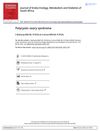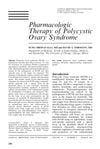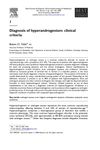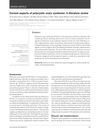TLDR MPA improved hormonal imbalances and acne in women with PCOS without affecting metabolism.
The study investigated the effects of medroxyprogesterone acetate (MPA) and ethinyl estradiol plus drospirenone on women with polycystic ovary syndrome (PCOS) over 6 months, involving 63 participants. MPA treatment resulted in significant decreases in luteinizing hormone, total testosterone, free androgen index, acne, and seborrhea scores, without affecting lipid or carbohydrate metabolism. In contrast, the ethinyl estradiol plus drospirenone group experienced increases in lipid and hormone values, while acne, seborrhea, hair loss, and Ferriman-Gallwey scores decreased. Both treatments did not significantly alter the total cholesterol to high-density cholesterol ratio. MPA was effective in controlling menstrual cycles and improving hormonal imbalances related to hyperandrogenism.
 9 citations
,
July 2009 in “Journal Of Endocrinology, Metabolism And Diabetes Of South Africa”
9 citations
,
July 2009 in “Journal Of Endocrinology, Metabolism And Diabetes Of South Africa” The document concludes that managing PCOS involves treating symptoms and reducing long-term metabolic risks, with lifestyle changes being important.
 37 citations
,
February 2007 in “Clinical Obstetrics and Gynecology”
37 citations
,
February 2007 in “Clinical Obstetrics and Gynecology” The document concludes that treating PCOS requires a combination of drugs to manage reproductive and metabolic symptoms, with more research needed on combination therapies.
 85 citations
,
June 2006 in “Best Practice & Research Clinical Endocrinology & Metabolism”
85 citations
,
June 2006 in “Best Practice & Research Clinical Endocrinology & Metabolism” The document concludes that hirsutism is the main sign for diagnosing hyperandrogenism, which requires a detailed patient history and physical exam.
 4809 citations
,
January 2004 in “Fertility and Sterility”
4809 citations
,
January 2004 in “Fertility and Sterility” The 2003 consensus updated PCOS diagnosis criteria and highlighted increased risks of diabetes and heart disease for those affected.
 15 citations
,
December 2016 in “Revista Da Associacao Medica Brasileira”
15 citations
,
December 2016 in “Revista Da Associacao Medica Brasileira” Polycystic ovary syndrome is a common hormonal disorder in women, linked to increased risk of metabolic and heart diseases, and needs more research for better understanding and treatment.
 2 citations
,
September 2016 in “Journal of skin and stem cell”
2 citations
,
September 2016 in “Journal of skin and stem cell” Acne is strongly linked to high BMI, hair loss, menstrual issues, family history, and eating too many sweets and fatty foods, but not to excessive hair growth.
 11 citations
,
August 2014 in “PubMed”
11 citations
,
August 2014 in “PubMed” Women with acne often have higher levels of male hormones and are more likely to be overweight, both of which can make acne worse.
 10 citations
,
January 2011 in “Skin therapy letter”
10 citations
,
January 2011 in “Skin therapy letter” Women with PCOS often have acne because of high androgen levels, and the article reviewed how to treat this type of acne.
 212 citations
,
May 2010 in “American Journal of Obstetrics and Gynecology”
212 citations
,
May 2010 in “American Journal of Obstetrics and Gynecology” Diagnosing PCOS in teenagers is challenging and should use strict criteria to avoid misdiagnosis and unnecessary worry.








